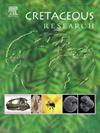New records of frogs (Anura, Lissamphibia) from the Late Cretaceous Bauru Group of Brazil and its paleobiogeographic implications
IF 1.9
3区 地球科学
Q1 GEOLOGY
引用次数: 0
Abstract
South America hosts one of the largest diversities of living frogs in the world, but our knowledge of the group during the Mesozoic Era is still limited. The Upper Cretaceous Bauru Group, in the south-central region of Brazil, has yielded a variety of vertebrate groups. Frog records are rare and restricted to a few well-preserved skeletons and fragmentary material. Nevertheless, they have offered important clues about the early diversification and distribution of frogs, especially among the speciose clade Neobatrachia. Here, we report new records of frogs from the Adamantina and Serra da Galga formations. The described specimens expand the geographical range of frogs in the Bauru Group and corroborate the hypothesis of a widespread distribution of neobatrachians in Gondwana landmasses by the Late Cretaceous. The discovery of the first putative Calyptocephalella-like form from a northern region in South America sheds light on the proposed biogeographic provincialism of frog faunas in South America by the Late Cretaceous.
巴西晚白垩世Bauru群蛙类(无尾目,lissamphiia)新记录及其古地理意义
南美洲是世界上现存青蛙种类最多的地区之一,但我们对中生代这一群体的了解仍然有限。在巴西中南部地区的上白垩纪Bauru群,已经产生了各种各样的脊椎动物群。青蛙的记录是罕见的,仅限于一些保存完好的骨架和碎片材料。尽管如此,它们还是为青蛙的早期多样化和分布提供了重要的线索,尤其是在新蛙科的物种分支中。在这里,我们报告了来自Adamantina和Serra da Galga地层的青蛙的新记录。所描述的标本扩大了bauuru组青蛙的地理范围,并证实了晚白垩纪在冈瓦纳大陆广泛分布的新蛙类的假设。在南美洲北部地区发现的第一个推测的类萼头蛙形式,为提出的白垩纪晚期南美洲青蛙动物群的生物地理地方性提供了线索。
本文章由计算机程序翻译,如有差异,请以英文原文为准。
求助全文
约1分钟内获得全文
求助全文
来源期刊

Cretaceous Research
地学-地质学
CiteScore
4.10
自引率
19.00%
发文量
235
审稿时长
12 weeks
期刊介绍:
Cretaceous Research provides a forum for the rapid publication of research on all aspects of the Cretaceous Period, including its boundaries with the Jurassic and Palaeogene. Authoritative papers reporting detailed investigations of Cretaceous stratigraphy and palaeontology, studies of regional geology, and reviews of recently published books are complemented by short communications of significant new findings.
Papers submitted to Cretaceous Research should place the research in a broad context, with emphasis placed towards our better understanding of the Cretaceous, that are therefore of interest to the diverse, international readership of the journal. Full length papers that focus solely on a local theme or area will not be accepted for publication; authors of short communications are encouraged to discuss how their findings are of relevance to the Cretaceous on a broad scale.
Research Areas include:
• Regional geology
• Stratigraphy and palaeontology
• Palaeobiology
• Palaeobiogeography
• Palaeoceanography
• Palaeoclimatology
• Evolutionary Palaeoecology
• Geochronology
• Global events.
 求助内容:
求助内容: 应助结果提醒方式:
应助结果提醒方式:


